World War 1 1914-18

It is difficult to know how many Navan men fought in WW1, as 60% of the WW1 military records were destroyed in the London Blitz during WW2. We know that around 130 men from Navan and its surrounding areas were killed in the Great War, out of an estimated 1000 who joined up. Based on the military records which survive, the average age of those who died was 27.6.
The sons of the local gentry were well represented and served in the officer corps. The Meath Chronicle lamented the loss of 2 members of the Meath Hunt. The first was Lt. Nigel Legge Burke (aged 24) of the Coldstream Guards, killed on Oct 14th 1914 near Ypres. His mother was a Lambert from Beauparc. The second was Lt. Kenneth Matheson (aged 28), from Tara Hall, who also died near Ypres on 1st Nov. 1914. 1
Capt. Arthur Preston, (29), Royal Dublin Fusiliers, from Swainstown Kilmessan was killed at Suvla Bay on Aug 15th 1915. He was mentioned in dispatches. Shortly before he was killed he had written cheerful letters home to his wife and father, declaring himself to be "full of buck and life." 2
Capt. R.C. Metge, son of R.H. Metge (M.P. for Meath 1880-1882) serving with the Leinster Regiment, was invalided home in 1916, dying at his home Athlumney House in Kilcarn in Oct. 1919. 3
The majority of those who enlisted were the ordinary working men of the town. Of the 110 military records relating to Navan which survive, 45% of the men describe themselves as labourers and a further 16% as farm labourers. Other trades mentioned include horse shoer/groom/ painter/carpenter/carter/butcher/fitter/sweep/slater/messenger/ bootmaker/tailor/ clerk. There was 1 electrician, 2 musicians and 1 student.
35% of the men came from the poorest parts of the town Barrack Lane , Sandymount and the little lanes off Trimgate and Watergate St. 28% gave no address so it is likely that the percentage of men coming from the poorest parts of the town is higher than the 35% mentioned.
Poverty may well have given some impetus for young men to enlist. Some joined in groups, called "Pal's Regiments". For example, we know that at least 22 members of Navan UDC joined the Leinsters, and the Post Office Rifles included 11 men from the Post Office Service of Meath. It would not appear that the Volunteers in the Navan area heeded Redmond's call in any great numbers. 13 are recorded from Navan (it is likely that the number was greater than this, but records haven't survived, and being a member of the National Volunteers was not recorded on the Enlistment forms) and 50% of the Johnstown and Kilmessan Volunteer corps joined up. 4
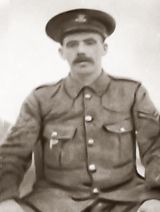
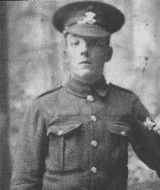
(left) Pte Michael Masterson from St. Finian's Tce. He worked as a labourer in Navan UDC before joining the Leinster Regiment. He served in France from Oct. 1914, and died of wounds 12th May 1915.
(right) Pte. Patrick Cregan Infirmary Hill. His family maintain he lied about his age in order to join the army, and the 1911 Census would bear this out. He served in the Leinsters. He died, officially aged 19, on the hospital ship Grantully Castle , during the ill fated Gallipoli Campaign. (on 27 Oct 1915.) His memorial is in Salonika, and his name is inscribed on the Drogheda War Memorial. Eight other Navan men died during the Gallipoli Campaign.
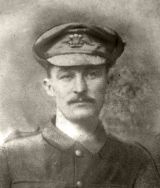
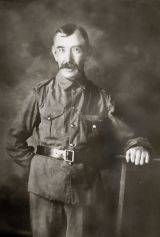
Older men (over 30) enlisting were often placed in the Army Service Corps, whose job was to organise supplies to the Front Line.
One of these was
Dvr. Mattie McGoona, (pictured left),
a saddler from Poolboy St. He enlisted aged 42, and he survived the war. He told his grandson Michael that during the Battle of the Somme he was stationed 2 miles east of the fighting.
Pte. Michael Cahill (above right) was a stoker by trade, and lived in New Lane with his wife Mary. He was in the Royal Meath Militia before the war, later joining the Leinsters. He served in France and was wounded in 1915, and sent home to recuperate. Rejoining the army in Oct. 1915, he served the rest of the war with the 6th Bn Leinsters in Palestine. His grandson Michael McGoona remembers hearing him talking of swimming in the Suez Canal. He survived the war, and later worked in the Scottish coalfields, and returning to Navan, in Claytons Woollen Mill, and later in the Gasworks in Mill lane.
The Rev. Nicholas Cooney, curate in Navan, served as Chaplain to the forces, but by 1918 he was giving a speech at an anti-conscription rally in Market Sq. where the Irish Times and the Evening Mail, papers favouring Irish conscription were burned amidst considerable cheering from the force of 200 Volunteers present. 5
Fr Ed Cullen, a Vincentian, from Liscarton, also served as Army Chaplain. A letter from him recounting his experiences has survived. (see: Navan and its People and the Great War, published in Navan - Its People and Its Past, Vol 2, Journal of the N&DHS ).
At least three young women volunteered to serve as nurses during the war. Hannah O' Rourke is recorded by Horneck as working in the Red Cross at Evereux. The Meath Chronicle in Feb. 1917 reported that Nurse Madeline O'Reilly a nurse in the Fever Hospital, had applied for leave of absence to serve at the front. The Navan Board of Guardians acceeded to her request, calling her "one of the ablest nurses in Meath."
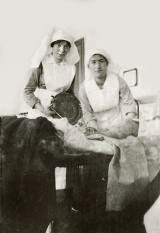
Raby Lowry, pictured left, was instrumental in organising
Christmas concerts in the Palace in Navan in 1914 and 1915,
to raise money for "comforts" to send out to the Leinsters.
In 1916, she is serving as a nurse in France.
She was a cousin of 2nd Lt. Joseph Lowry who was killed
at Baupaume in 1918. (see below)
Nurse Raby Lowry is pictured on the left of the photo above. Photo courtesy of the Spicer Family.
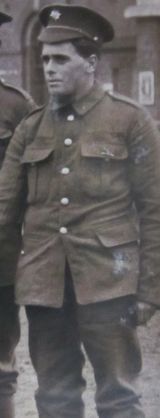
Navan men fought in virtually every theatre of war.
The majority found themselves posted to the Western Front in the area around Ypres and on the Somme.
They fought in all the great battles, including Mons, Marne, Loos, Somme, Ypres, and Passchendaele .
Illustrated left is Corp. Michael Colclough from the Kells Rd. who served with the Irish Guards before dying on 29th Oct 1915, of wounds received during the Battle of Loos. He was a member of the National Volunteers before enlisting. A letter from him survives, published originally in the Meath Chronicle (2 Oct 1915) and in Navan - Its People and its Past, Vol 2.
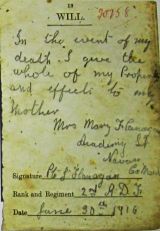
Two Navan men died on the horrifiic
first day of the
Battle of the Somme 1 July 1916.
They were Corp. Joseph Gorman from
Brews Hill, who was a L/Corp in the Irish Rifles, and Pte. James Flanagan (age 21) from Academy St.
The day before he died James wrote his will in the back of his soldier's notebook. It is reproduced (right) thanks to the National Archives of Ireland.
Pte. Jack Brien spent 4 years in the trenches and survived the war.
He enlisted aged 151/2 in Market Sq. where a stand had been erected and a band was playing. Without ID, but being a tall young man, with a willingness to go, the recruiting sergeant took him on - "you'll stop a bullet." As he was a groom, he originally served in the Southern Irish Horse Regiment, which as the war went on and losses mounted, was amalgamated into the Leinsters, then the Connacht Rangers and finally the Dublin Fusiliers. He spent the 4 years of the war in the Somme area. Jack survived the war, but was gassed, (a bullet had cut through the breathing tube of his gas mask - they told him in the field hospital that his life was saved because he hadn't eaten for 2 days, - food in the stomach aggravates the gas, usually fatally). Despite having only having the capacity of one lung, Jack became a champion cyclist in later years. 6
One Navan man was awarded the DCM. He was Sgt. Christopher Rogers a fitter from O'Growney Tce. who served in the Royal Field Artillery. A shell splinter hit him on the back of the head near Ypres, on 27th March 1916, and he died 45 minutes later without regaining consciousness. He was aged 33. He had served in every bombardment from Mons to his death, and had lucky escapes. He was twice mentioned in dispatches. His C.O. in a letter to his widow, stated "I have known Sgt. Rogers since I joined the Battery, and have nothing but the highest praise for him, both as a good NCO and a skilled workman, and I know that this is the opinion of all officiers in the Battery." During the battle of the Aisne, he volunteered and succeeded in repairing two guns which had been put of action, while under heavy shelling. 7
Two Navan men lost their lives during the only naval battle of the war, the Battle of Jutland, which took place between the 31st May -1st June 1916. One was Lawrence Hamilton (39), a stoker on HMS Black Prince, and son of John and Ellen Hamilton Dean Hill Navan. The ship was pounded by shells form all sides and at close range, and sank rapidly in 15 minutes with the loss of all hands (over 800 men).
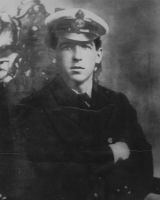 John Alfred Keappock aged 26, (pictured left),
John Alfred Keappock aged 26, (pictured left),
was the son of Joseph and Catherine Keappock Claremont House, Navan.
He was an engineer on the HMS Shark, which was torpedoed on the 31st May during the height of the battle. The ship went down with its flag flying and only 6 of its crew surviving.
He was described as being "...of a manly and chivalrous character, ...he was a prime favourite among his comrades."
KEAPPOCK, John Alfred. Royal Navy, H.M.S. “Shark”, Engine Room Artificer 4th Class. M/4997. Son of Joseph and Catherine Keappock, Claremount, Navan. Father’s occupation: Merchant. Drowned off Jutland following a battle in the North Sea, 31 May 1916. Age: 26.
Memorial: 15, Portsmouth Naval Memorial.
Navan Bluejacket Missing
On Monday last Mr. Joseph Keappock U.D.C. Navan, received notification that his second eldest son, John, who was a second hand artificer on board the “Shark,” was missing. Since then the list of survivors from this vessel has been published, but his name does not appear in it. Although official notification of his death has not been received it is feared that his chances of having been saved are remote. When about 23 he joined H.M.S. “Harrier” on which he remained about six months and was then transferred to the “Shark” on which he spent the last two years.”
Meath Chronicle 10 June 1916.
Navan Man Lost in North Sea Fight
Last week Mr. John Keappock, employed as engineer on the H.M.S. Shark, sunk in the North Sea battle, was reported as missing. We regret to say that the worst fears of his friends have been realised. His father, Mr. Joseph Keappock, U.D.C., has received a communication from the Admirality intimating their belief that the gallant young fellow had been numbered among the victims of what has been described as the greatest sea fight in the world’s history. Mr. Keappock was considered exceptionally clever at his work and had every prospect of a distinguished career in the navy. Of a manly and chivalrous character, he was a prime favourite amongst his comrades. The fact that he was engaged to be married adds a pathetic feature to the sadness of his untimely death which is mourned by many friends.”
Meath Chronicle 17 June 1916.
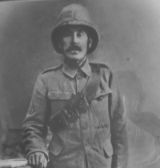
James Cahill, (pictured right) was a
shoeing smith (blacksmith) from St. Patrick's Tce,
who served in Egypt during the war.
Before enlisting in 1915, he had a forge in Metges Lane Navan.
He was severely injured by a kick from a horse or mule, and was discharged as "being no longer fit for military service, character good." His request for a pension was rejected. He died of his wounds in hospital in Dublin on 27th Oct 1917.
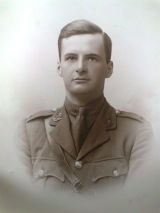
2nd Lt. Joseph Lowry (pictured left),
was killed in the closing months of the war, aged 20. He was the son of Albert and Olivia Lowry and was living at Bachelor's Lodge Navan, at the outbreak of war.
Joseph served in the Royal Irish Regiment, and was killed during the liberation of Bapaume, which had been occupied by the Germans for 4 years.
The Allies entered and liberated the town in Aug 1918. Joseph was killed in action on 25th Aug 1918.
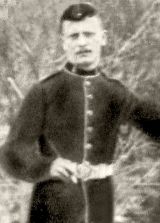
The Sheridan family, who had a shop in Market Sq. Navan, lost 2 sons on the Western Front. They were Pte. William Sheridan from the Irish Guards who died aged 22, on the 18th May 1915. The following year his brother, Corp. Bryan Sheridan was killed in action during the Somme offensive on 3rd June 1916. A third brother Philip, was a POW, but survived the war.
John and Julia Monaghan of Railway St. also lost 2 sons as a result of the war. They were Pte Thomas Monaghan, aged 27, who died on 2nd Oct. 1918 as a result of injuries received in Flanders. His brother Lawrence Monaghan Rough Rider Royal Army Service, (pictured right) died from complications after a horse fell on him during training in Exeter. He died on 23rd Feb. 1919. His memorial is in Old Kilcarn Graveyard.
Another man who died of his injuries after the war was over was Charles Joseph Walsh of the Irish Guards, (and also a member of the National Volunteers). He was a member of the "Clock" Walsh family of Watergate St. He was blown up into the air when a shell exploded near him as he was carrying a dispatch near the front line at Neuve Chapelle in 1915. Severe spinal injuries resulted and he died back in Navan in 1919. 8
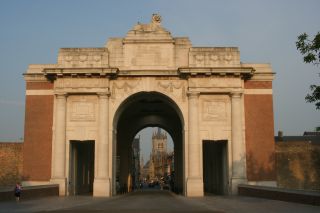 The Menin Gate
The Menin Gate
(pictured left, with the rebuilt city of
Ypres visible through its arch)
contains the names of over
54,000 men who died in this area,
and for whom there are no known graves.
It includes the names of 8 Navan men.
Pictured below is one of the panels on the Menin Gate showing the names of soldiers from the Leinster Regiment who fell in Flanders during the Great War and for whom there are no known graves.
Among them are L/Corp. Joseph Kerrigan aged 25, from Railway St. who was killed in action on 13th Jan. 1915 and L/Corp. Patrick Hennessey aged 19 from Flower Hill who was killed in action in Flanders on 31st July 1917.
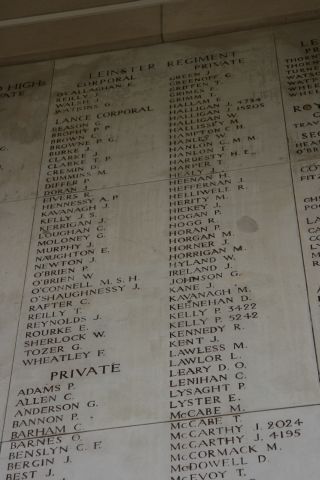
Every night at 8pm, the traffic is stopped, a silence falls, and the Last Post is played. This ceremony has been going on here since 1928, performed by members of the Ypres (Ieper) Fire Brigade.
The names of Navan men who fell in battle and who have no known graves can also be found on the memorial panels in Tyne Cot cemetery in Flanders, Thiepval on the Somme, Gallipoli and Basra (modern day Iraq), along with many other smaller cemeteries.
*******
Some nicknames of Navan men who served in the war have been recorded. The "Trenches" McDonald sat in Market Sq. maybe alongside the "Ypres" Bradley and the "Straits" Cahill. 9
The Meath Chronicle reported on May 29th 1920: "From a hop in midfield, "Salonika" kicked to the goal mouth and after a short tussle the ball was sent wide ... Rogers again got possession and put in an effective shot to the danger zone, and the ball was sent over the bar for the second time."
Final Score : Harps 4 Rathkenny 1
*******
Below are some notices from the London Times relating to Navan and WW1:
The Times, 23 Dec 1914: Sick and Wounded Fund subscribers to the Millers Gift.....£25 each... J. Spicer and Co. Ltd., Navan.
The Times, 16 Jan 1917 War Dead. Royal Munster Fusiliers- P. Caffrey 18027 Navan.
The Times, 28 June 1917 On the 26th June, from wounds received in action the previous day, 2nd Lieutenant John Spencer Dunville, Dragoons, 2nd son of Flight Commander John Dunville, of Redbarn, Hollywood, Co. Down, and Sion, Navan, Co. Meath, aged 21 years.
The Times, 19 April 1918: ...A large number of meetings were held yesterday, and resolutions of protest and defiance against conscription were passed with enthusiasm. Unionist newspapers which support conscription were burned publicly at Navan...
The Times, 23 June 1919: Bravery in the Field. War Office June 17th The King has been pleased to approve of the award of the military medal for bravery to the following...Irish Guards, 10732 Pte., Boyle P., 1st Bn. Navan.
*******
Sources:
1. Meath Chronicle, 21 November 1914
2. Ruvigny's Roll of Honour, 1914-24, Vol. 1
3. The Meath War Dead, Noel French, History Press, Ireland, 2011, p.116
4. A.J. Horneck, Meath Roll of Honour orig. published in The Leinster Leader March 1916. (Accessible online).
5. Irish Independent, 18 April 1918
6. For a fuller accounf of Jack Brien's war experiences Navan - Its People and Its Past, Vol 2, pp.123-125
7. Drogheda Independent, May 13 1916
8. Meath Chronicle, 29 Nov 1919
9. The list of old Navan nicknames, was compiled by Johnny Mangan and Willie Reilly and is held in the Meath Co. Archive in the Co. Library Navan
Meath Chronicle Archives
WW1 Military Archives accessed through www.ancestry.co.uk
Navan and Its People and the Great War, parts 1 & 2, Ethna Cantwell, in Navan - Its People & its Past Vols.2 and 3 - Journal of the Navan & District Historical Society, 2013 and 2015
The Meath War Dead - A History of the Casualties of the Great War, Noel French, History Press, 2011.